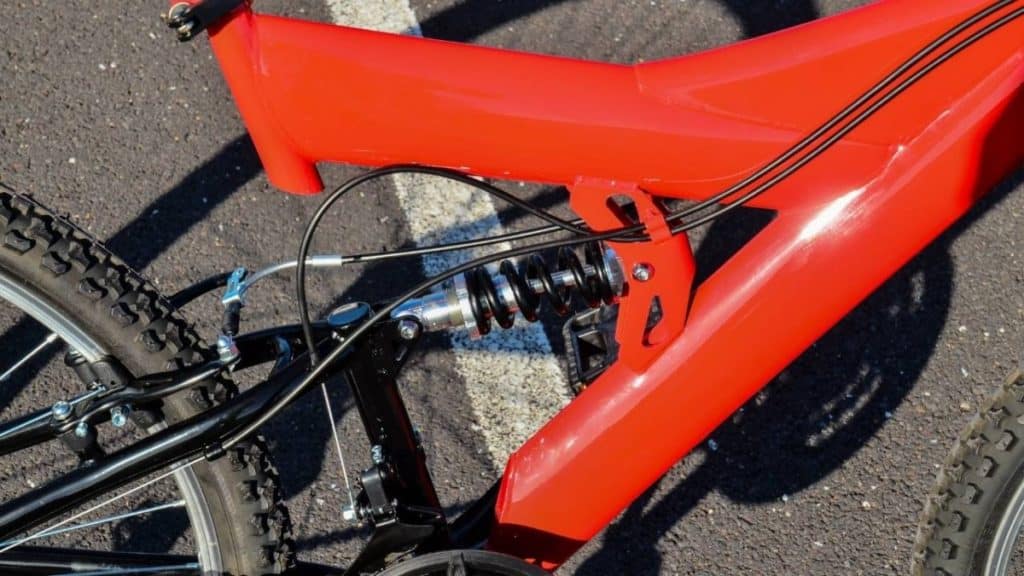
You can explore the internet and view thousands of varieties of bike designs and makes. And you will discover the vast majority have some sort of suspension fitted. For instance, the downhill mountain bike seems to have more suspension than bike frame.
But why don’t we commonly see suspensions on road bikes? Is it due to weight or the design of the bike And is it better to have a suspension on your road bike or not?
Typically, road bikes do not have suspension in a traditional sense, at least not like other types of bikes such as mountain bikes. Road bikes have design features and materials that dampen vibration and act similarly to suspension, ultimately making cycling more comfortable.
Table of Contents
Do Road Bikes Have Suspensions?

The evolution of road bikes has developed over the years, and manufacturers search to make riders more comfortable while producing an economic frame that produces the most power as efficiently as possible. While road bikes were commonly made using hardwood timber in the early days, these cumbersome designs were heavy and not overly durable.
As manufacturing techniques improved, wooden frame bikes were swiftly abandoned, and steel tubing was used to create road bikes. Steel tubed road bike frames were incredibly robust. However, they were also incredibly heavy.
Nowadays, the quest for lighter, more responsive, and more durable bikes has led designers to make road bike frames with steel, aluminium, titanium, and even carbon fibre.
These highly malleable materials also provide more advanced levels of flex in certain parts of the bike frame.
For example, the front fork and rear fixed tail section that holds the wheels. Because these sections of the road bike flex, there is no requirement to have additional suspension. Advancements in bike frame geometry and aerodynamics have also reduced vibration and rider fatigue.
The most advanced endurance road bikes are created for extended durations in the saddle and offer the most comfortable ride without the need for conventional suspension, as seen on mountain bikes.
Why Don’t Road Bikes Have Suspension?
While we speak of form and function, it’s worth discussing why road bikes don’t have suspension, which ultimately comes down to performance, weight and necessity. Besides overwhelming ambitions of taking your road bike on gravel trails or off on a folly in the snow.
Road bikes throughout the years have primarily been designed for cycling on the road with racing and speed in mind, and there is only one enemy of speed, weight. The heavier your bike is, the harder it will be for you to handle it and generate top speeds.
Just try riding a 30kg bike uphill. It’s obviously going to be more of a calf-burner than cycling uphill with a 6kg road racing bike under the saddle. Designers have spent many hours studiously creating every component on the modern-day road bike.
They are shaving mere grams of weight from each bike part and striving for the victory of making the lightest and most aerodynamic design on the market.
However, many a late night has been wasted in vain ‘over-designing parts that can simply be removed once and for all, and for this example, the suspension is top of the list for most road bike manufacturers in the current bike market.
The racers and the riders want clean aerodynamic lines and ultra-lightweight frames that can be lifted with a pinky finger on one hand while sipping an espresso on the other.
They want powerful pedal-cleated strides that translate into expressive thrusts supported and firmly endorsed by a glossy yet surprisingly robust bike frame.
They want speed, and above all, they want power. Sadly for suspension, it just doesn’t tick any of those boxes. Conventional suspension systems today weigh bikes down and, in many cases, drastically reduce the pedal-to-power ratio. It’s a shocking truth, but the suspension is out for road bikes in the foreseeable future.

Do Road Bikes Need Suspension?
Generally, road bikes do not need suspension. It is seen as a costly design feature that will weigh down the aerodynamic nature of road bike frames and subsequently reduce the frame’s performance, speed and overall weight.
However, suspension-like technology has existed in road bikes for many years. One of the most obvious advancements that road bikes have made over other bike types is their handlebar design.
Drop bars allow for 3 different hand positions for cyclists, and this carries a huge advantage of allowing a rider to distribute the load of riding over different parts of the hand. If one part becomes sore, you can just change position and keep on riding.

Bike Build Materials and Road Bike Manufacturing
Damping technology and advanced manufacturing processes have also played a crucial role in replacing suspension on road bikes. Handlebar tape not only allows for a solid and sturdy grip in all conditions but also dampens vibrations reaching the hands, allowing for a more comfortable ride.
The same can be said about the forks of modern bike frames, with many steel or alloy framed bikes using a more flexible material for the front forks. One of the most common materials used is carbon fibre, and that is due to its superior damping quality while also being incredibly lightweight and mouldable to any shape.
Of course, one part of your body takes the brunt of the impact on any bike, and that’s the butt. Get it right, and you’ll enjoy cycling with all the comfort and ability afforded. Get it wrong, and well, it’s a real pain in the butt!
Using a comfortable seat is crucial for comfortable riding, and this is especially important on a road bike. You’re often going at a very high speed, which generates a lot of rapid vibrations that need to be dampened by the frame, the handlebars, and the seat.
For this reason, there’s a lot of technology going into the materials and ergonomics used in bike seats. Bike seats are often made using carbon fibre and high-density silicone to allow the rider’s best ergonomic fit. To discover ways to reduce saddle soreness, check out this article.

Will Road Bikes Have Suspensions In The Future?
While it is unusual for road bikes to have conventional suspension, there have been advancements in bike frame and damping technology in recent years, including introducing and field testing suspension ‘systems’ on road bikes.
In recent years, the designers’ pen has also hovered between designing ‘hybrid’ and ‘road racing’ bikes by definition, and this is evident in the constant tweaking and refinement of road bike frame design.
The stroke of the pen is a blur with activity, keeping up with the ever-changing technology, manufacturing processes, and perception of what a ‘road’ bike is used for that ultimately informs a designer’s decisions.
Young riders are entering the sport in droves, with many using road bikes in more non-conventional ways than they were intended for.
They often take their trusted stead on more extreme terrain or perform more difficult cycling manoeuvres in unfavourable conditions such as snow or ice.
This will have two effects on the ‘classic road bike’ design, morphing the preconceived perception of what a road bike is capable of, and secondly, in the technology and design that will ultimately follow.
So perhaps sometime in the future, road bike suspension will be the norm? After all, form follows function.
Do Road Bikes Have Suspension Summary
Hopefully I have explained why traditionally road bikes don’t have suspensions but that it is a strong possibility to see them more frequently in the future. Suspensions are different necessary on mountain bikes or off-road bikes but not as important on a standard road bike.
The purpose for most road bikes is to remain strong and robust but weigh less than other styles of bike. So, fitting suspension systems to road bikes just adds more weight to the frame.



